Whether you are caught in a white-out, needing to navigate trails or provide emergency first aid, it is imperative hikers are properly equipped on their Highland adventures. Otherwise we would rely too heavily on Mountain Rescue for preventative emergencies!
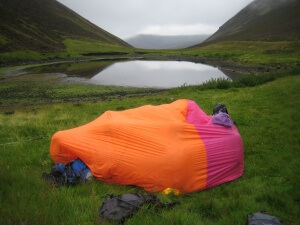 Keeping gear dry is a must. Photo courtesy of Complete Cairngorms participant, Alison Hedley
Keeping gear dry is a must. Photo courtesy of Complete Cairngorms participant, Alison HedleyHere in Scotland’s Highlands the terrain and weather can be deceptive as our tallest peak Ben Nevis is 1,345 metres. However, the tree line in Scotland begins around 6-800 metres. Higher winds and colder and changeable weather thus occur lower down in Scotland at the same severity. This means, effectively, the environment you get at 600 metres is the same at 3,000 metres in the Alps.
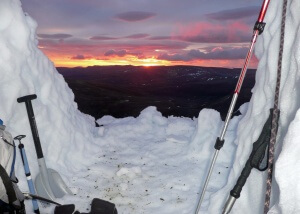 Some Full moon Snow-hole Expedition gear: snow shovel, ice axe, trekking pole, rope, rucksack
Some Full moon Snow-hole Expedition gear: snow shovel, ice axe, trekking pole, rope, rucksackTo protect ourselves from Scotland weather we prepare with the proper gear. Cioch Outdoor Clothing is a Scottish based manufacturer on the Isle of Skye, and along with being comfortable and durable they also provide excellent customer service.
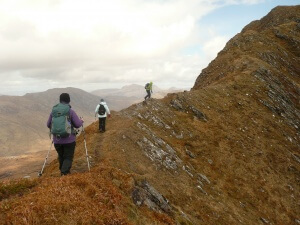 Wild Knoydart: walkers know the value of a good pack!
Wild Knoydart: walkers know the value of a good pack!Nikwax Analogy material made to measure by Cioch and Páramo clothing, an ethical manufacturer, are favourites of Andy. He values these for their waterproof and windproof properties, essential to weathering Scotland’s worst. Many are surprised by the severity of “wind chill”. (Wind chill is the effect of the wind in cold weather, which makes the actual temperature feel so much colder than the thermometer records.) Wind chill creates a high risk of hypothermia. Extra layers are a must.
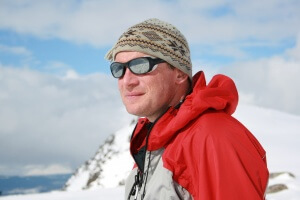 Andy in a Nikwax Analogy smock jacket by Páramo
Andy in a Nikwax Analogy smock jacket by PáramoKey features: never go without a map and compass, and pay special attention to foot care. Proper walking boots are essential. In general the heavier the boot, the more equipped you will be, and stiffer boots are best for dealing with snow.
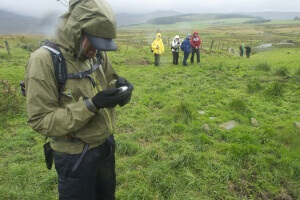 Scotland – ATTA – Adventure Travel World Summit; Spirit of the Cairngorms. Compass for navigation.
Scotland – ATTA – Adventure Travel World Summit; Spirit of the Cairngorms. Compass for navigation.How does Gore-Tex compare to its competitors? Do you need to splurge on expensive gear for a single trip? Our resident guide Andy Bateman is an expert in questions like these.
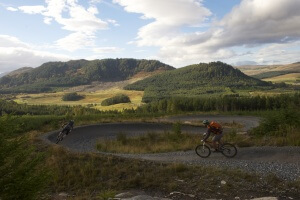 Scotland – ATTA – Adventure Travel World Summit; Spirit of the Cairngorms. A bike you can depend on
Scotland – ATTA – Adventure Travel World Summit; Spirit of the Cairngorms. A bike you can depend onWe provide advice on the kit you will need, because the best gear makes you forget the job it is doing, and leaves you to soak in your adventures instead.
Many of our guests want to go hiking in the Cairngorms National Park. It is their primary reason for coming to stay with us. The most popular hike in the area is one lasting about 4 hours and preferably ascending a wee bit of a hill. This is the hike we usually recommend.
Be aware though – that this hike will not get you off the beaten track (as far as we are concerned) which is what Scot Mountain Holidays specialises in offering to our clients. You will see other hikers, particularly on the approach to the hill i.e. on the path up to Ryvoan Bothy.
Meall a’Bhucaille (Shepherd’s hill)
A popular “hill” hike suitable for almost anyone wanting to go hiking in the Cairngorms
3 – 4 hours
810m
Glenmore, Loch Morlich, Cairngorm, the Lairig Ghru, Boat of Garten, Abernethy Forest
in Glenmore either at the Visitor information centre or at the end of the road by Glenmore Lodge.
We would recommend starting the hike by passing in front of Glenmore Lodge but perhaps the better place to park would be the Forestry Commission visitor information centre, even though it is pay and display and the parking on the roadside outside Glenmore Lodge is free.
Start by heading out from the Visitor Information Centre at Glenmore along the footpath which passes in front of the reindeer centre and then on towards Glenmore Lodge.
Continue on the footpath with takes over from the end of the road, heading towards the Green Lochan.
The path is wide and well-maintained. Before you reach Ryvoan Bothy, you’ll pass the Green Lochan, which is a pretty spot to take a breather.
You’ll turn at the bothy to head up the hill but you may want to make it your lunch spot as it will provide a shelter.
The path is obvious at the bothy. It heads up the hill towards the summit.
You’ll know when you reach the main summit as there is a large stone built shelter at the top with a magnificent view of Loch Morlich and the Cairngorms behind.
Instead of returning along the path you came up, head down to the saddle between Meall a’Bhucaille and Craigowrie and down the path from here back to Glenmore (this is a shorter return route).
If you would prefer to get further away from the “crowds”, try joining a guided or self-guided trip with Scot Mountain Holidays. We specialise in exposing hidden gems for our guests to explore under the guidance of our expert and experienced local leaders.
Where should you go for the best autumnal pictures you can get in the Cairngorms National Park? It’s a secret! But one we’re willing to share for our local area. We don’t think it will spoil things too desperately as you can only get to this route if you’re driving and there is no parking for buses or coaches.
If you come to stay at Fraoch Lodge, no doubt you’ll be looking for some hiking advice. It’s only natural, we are very knowledgeable, especially as Andy is a mountain leader, with a well-deserved reputation as a walking guide. Even our international guests in the height of the summer months are looking for some help finding good quality hikes.
Is this the prettiest time to visit the Cairngorms? There might be some debate about that as many find the snow-clad hills of winter stunning. However, there can be no debate about this being the most colourful time of year.
Our top pick would be a hike in Glen Feshie. Glen Feshie is definitely one of the prettiest parts of the northern area of the National Park. If you’re hiking a there and back route along the bottom of the glen, this is a route we would recommend for almost all abilities and can also be turned into a mountain biking adventure.
For a more adventurous route, or to turn the hike into a circuit feel free to consult with Andy or book his services as a guide.
Start of the hike: Achlean Car Park (Start Grid Ref NN850985)
Finish of the hike: Achlean Car Park
There’s no public transport option to access the start of this hike.
Total route includes ascent of the Munro summit of Mullach Clach a’Blair.
Habitats: Pine Forest, moorland, mountain tundra
Distance: 22.5km / 14 miles
Time: 7 – 8 hours
Ascent: 785m
If you don’t want to go all the way to the summit of Mullach Clach a Blair, it is still a perfectly lovely walk to go along the river Feshie as far as you want or until the bothy before returning to your car. You won’t pass through as many habitats and won’t come across ptarmigan, but you might still see roe or even red deer, numerous forest birds including the ever present chaffinches and possibly Scottish crossbills if you’re lucky.
You might also want to consider a mid-level hike. Watch out for our blog on the most popular hike in the Cairngorms: Meall a’Bhucaille.
With September now behind us and autumn storms bearing down, summer days are now a distant memory. Daylight is shortening and snow showers are forecasted for the high summits. And although it might be a few weeks yet before the ground is cold enough for snow to settle. Now’s the time to consider what extra items you’ll be carrying in your rucksack to hike through Scotland’s Autumn Mountains.
1. Headtorch
If you haven’t been carrying one up until now, now’s the time. Firstly, make sure the batteries are fresh and you’re carrying spares. What might appear as batteries with plenty of charge in a warm environment can quickly diminish in the cold of the mountains. Navigating in dark hill fog you’re bound to be using a head-torch on the highest beam. You’ll find this drains your power very quickly.
If your torch isn’t very powerful it may be worth thinking about upgrading. Don’t underestimate how much difference a quality torch can make to your journey when having to navigate. Your fingers will also thank you, as there is nothing worse then trying to change batteries and dealing with gloves in bad conditions.
2. Ski Goggles
There is now the chance of precipitation in the solid form on the wind both on fine and not so fine days. Remember, the wind doesn’t have to be too strong for drifting to occur. Do not underestimate how unpleasant it can be walking into the wind when snow, hail or spin-drifts are hitting you directly in the face.
Ski goggles are something you don’t want to skimp on either. Being able to see properly is of vital importance so make sure you get a decent pair of anti-fog (double lens) goggles. In a damp mountain climate you’ll find cheaper goggles will quickly fog up if they aren’t the right spec. A decent pair will also keep your face so much warmer in the biting Highland cold.
3. A warm hat
A warmer hat than you might carry in summer is both common sense, and of vital importance. We recommend one that pulls down over the ears!
4. Warmer Gloves
If you have ever suffered from the pain of hot aches you’ll know investing in a pair of really warm gloves is a must-make purchase. A pair of light liners inside thicker gloves works well as there is a play-off between warmth and dexterity. Don’t fall into the trap of thinking you can get the best of both worlds with just one pair of gloves.
Gloves of adequate warmth for the coldest of Scottish winter days won’t have much dexterity left. So, it’s a case of whipping your hands out for fiddly activities and then putting them back into those cosy mitts. The liners also help to keep the gloves hygienic, making the task of cleaning your gloves so much easier.
5. An extra warm layer
Carry an extra warm layer for when you are immobile. By far the best way of keeping warm is to keep active but there will be times when you have to stop. Even a relatively short break of just ten minutes can mean you chill significantly.
In our damp and often cold and windy mountain environment, hypothermia is often an ever-present threat. But donning an extra thick fleece or even better, an overlay jacket will save you from the threat of a chill.
6. Get you navigational gear organised
This can pay handsome dividends and will mean less time hanging around immobile getting cold and more time on the move keeping warm.
Navigational judgment can start to be one of the first casualties of being cold, so it’s important to have a map case. It not only protects the map but it also is a means you can anchor the map to yourself. Make sure you have a compass with a decent sized base plate…
More on this in a later blog!
All content © Copyright Scot Mountain Holidays 2025
Responsive web design by Summit Web Solutions